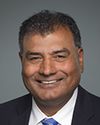Thank you.
Mr. Chair, thank you for inviting us to appear before the committee today.
Immigration, Refugees and Citizenship Canada, or IRCC, appreciates the committee's decision to undertake this study.
Canada's medical admissibility policies and guidelines play a critical role in the immigration system. As a result of the increasing number of migrants to Canada and the health risks associated with migration, there is an ongoing need to assess the health status of immigrants. This screening identifies health and safety risks and helps reduce impacts on Canada's health and social systems.
As the committee is aware, under the Immigration and Refugee Protection Act, permanent resident applicants and some temporary resident applicants may be refused admission to Canada if they have a health condition that would pose a risk to public health or public safety or would place an excessive demand on health or social services, which are mostly administered by provincial and territorial governments.
Health admissibility is determined through a two-stage process.
First, applicants undergo an immigration medical examination, including any supplementary tests, which are performed by a third party physician designated by IRCC. The department then performs an assessment of the examination's results to reach a decision on whether an individual is medically admissible. The department also notifies provincial and territorial public health authorities of the arrival of individuals who may require ongoing medical surveillance and follow-up for conditions such as inactive or previously treated tuberculosis.
In general, individuals are found to be inadmissible for public health reasons if they have a highly communicable disease that could have a serious impact on other persons living in Canada. Active tuberculosis and untreated syphilis are considered dangerous to the public, for example.
A finding of danger to public safety considers whether a foreign national's health condition could create a danger to the health or safety of persons living in Canada. This may include certain medical health conditions that could result in unpredictable or violent behaviour, such as sociopathic disorders.
In terms of the excessive demand provision, although the specific requirements have changed over time, there has been some form of screening for immigrants to Canada to minimize impacts on health and social services for most of our history. Currently, under the Immigration and Refugee Protection Act, this provision applies to all applicants for permanent residency, with the exception of convention refugees, protected persons, and some members of the family class—for example, spouses, partners, and direct dependents. Excessive demand also applies to some applicants for temporary residency, where these are eligible for provincial or territorial services.
The objective of the provision is to strike a balance between protecting publicly funded health and social services and facilitating immigration to Canada, while also supporting humanitarian and compassionate objectives in Canada's immigration policy.
Excessive demand considerations are determined by a departmental officer, usually referred to as a visa or immigration officer. These officers consider the assessment of an applicant's immigration medical exam by a departmental medical official, as well as projected health or social services needs, the cost of those services in Canada, and the effect on wait-lists.
This entails reviewing the medical diagnosis and prognosis, the required services, the costs for services in the intended jurisdiction of residence, and, in the case of social services or prescription medication, the ability and willingness of the applicant to pay out of pocket. If the individual's anticipated costs are expected to be above the average per capita cost of publicly funded services over five years, which is $33,275 as of January 1, 2017, then the individual may be found inadmissible.
No specific health condition will result in an automatic rejection of an applicant. Each decision is made on an individual basis.
The provision has been found by our courts not to violate the Charter of Rights and Freedoms, as it does not exclude persons based on a specific health condition. Rather, the decision is made according to an individual's likely demand on Canada's health and social services.
Of the approximately half a million medical exams performed annually by IRCC in recent years, only 900 to 1,000 applicants, or 0.2% of all applicants, received a finding of excessive demand by a medical officer. This includes about 200 to 300 individuals needing special education services.
The health inadmissibility provisions are designed, in part, to reduce impacts on Canada's publicly funded health and social services systems. We recently undertook a cost-benefit analysis, using data from 2014 arrivals.
The conclusion from the cost-benefit analysis was that the excessive demand provision results in avoided costs for provincial-territorial health and social services on the order of $135 million over five years, for each year of decision. That amount represents 0.1% of all the provincial and territorial health spending in 2015.
As you may know, IRCC has undertaken a fundamental review of the excessive demand provision. As part of this review, we launched consultations with provinces and territories in October 2016. Departmental officials also engaged stakeholders, including disability advocates.
The results of these discussions, together with consideration of public perspectives, judicial decisions, media reports, and internal departmental analyses, will inform the development of options to be presented for decision by the government.
As Minister Hussen recently stated at a federal-provincial-territorial meeting of his counterparts, “...with the cooperation of the provinces and territories, I'm pretty confident that we will arrive at a place where we can both live up to the need to protect our health and social services from excessive costs, while also treating people fairly and including individuals with disabilities.”
In summary, I will say that IRCC's medical screening program takes a risk-based approach that balances the facilitation of immigration with the protection of federal, provincial and territorial health and social services.
Once again, Immigration, Refugees and Citizenship Canada appreciates that the committee has chosen to undertake a study of the immigration medical screening policy.
Thank you very much.
We look forward to answering your questions.










